Mon Feb. 9 (day 1)
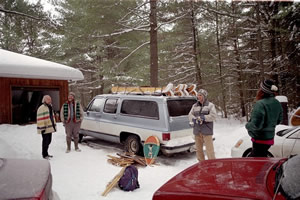
First thing in the morning, we rendezvoused at Craig’s house just west of the park gates. There I met the other people, some for them for the first time (Don, Neil, Bob), others a re-acquaintance (Dick, Craig). Ken I knew pretty well after several years of summer and winter weekend trips. At the last minute, Karl had to drop out thus our group was going to be seven. I was the only woman on the trip, which didn’t phase me although I was asked if I was going to wash my hair every night. I wasn’t sure if that was a serious question or not and let it slide.
The toboggans that I was expecting to use would in fact be komatiks, a style favoured by Inuit. The major difference is that instead of the wood platform sliding directly on the snow, the main body of the sled is raised up on wood runners. In theory, a komatik should be easier to pull than a toboggan especially if we run into mild or slushy conditions as there is less ‘rolling’ resistance (narrow runners vs wide plank bottom). The komatiks were 17” wide by 8’6” long and weight about 47 lbs each (empty).
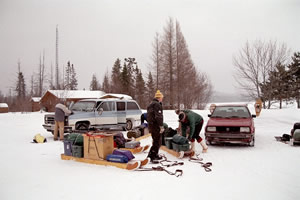 By 11am we were on the road passing by Huntsville. At 1pm we’ve turned off Hwy 11 at South River and are heading towards Algonquin’s west boundary near Kawayaymog Lake. Finally reaching the end of the road and access point parking lot, we unload the gear, divvie it up and bungee cord it to the komatiks. Most of the food is packed into Rubbermaid boxes, their lids secured with string ties downs case of sled tip over. The tent is folded and loosely packed in a large cardboard box. Because we are going over routes that are not routinely traveled in the winter and in some places rarely traveled in the summer, we expect to be doing some trail clearing. For this purpose, Bob has brought a chainsaw, fuel, oil and a hard hat along; everything is carefully stored in a wood wanigan. Clothing, sleeping bags are packed in soft packs of various sizes, shapes and designs. The wood stove, stove pipe sections, metal leg floats, metal ash shovel are stored inside the hollow body of the stove. Odds and ends like axes (we have at least 7), spare snow shoes, bow saws, ice chisel are stowed along side where ever they fit. The kitchen kit (pots, pails, wash tub, candle holders, cutlery, etc etc) travels in another wood wanigan. These sleds are heavy!
By 11am we were on the road passing by Huntsville. At 1pm we’ve turned off Hwy 11 at South River and are heading towards Algonquin’s west boundary near Kawayaymog Lake. Finally reaching the end of the road and access point parking lot, we unload the gear, divvie it up and bungee cord it to the komatiks. Most of the food is packed into Rubbermaid boxes, their lids secured with string ties downs case of sled tip over. The tent is folded and loosely packed in a large cardboard box. Because we are going over routes that are not routinely traveled in the winter and in some places rarely traveled in the summer, we expect to be doing some trail clearing. For this purpose, Bob has brought a chainsaw, fuel, oil and a hard hat along; everything is carefully stored in a wood wanigan. Clothing, sleeping bags are packed in soft packs of various sizes, shapes and designs. The wood stove, stove pipe sections, metal leg floats, metal ash shovel are stored inside the hollow body of the stove. Odds and ends like axes (we have at least 7), spare snow shoes, bow saws, ice chisel are stowed along side where ever they fit. The kitchen kit (pots, pails, wash tub, candle holders, cutlery, etc etc) travels in another wood wanigan. These sleds are heavy!
Pulling is fairly straight forward. We walk single file, the lead person with the map and no komatik. Every 10 minutes or so we rotate up the line, moving forward one sled. The person who broke trail with no sled then goes to the rear of the line and pulls that sled. Everyone gets to try different sleds, breaking trail and map reading. The heaviest sleds are positioned at the rear where the trail is most hard packed and gliding/sliding should be easier. I’ve not done the rotation method before but like it as each sled seems to slide a bit differently and the chance break trail over virgin snow is exhilarating (although tiring when deep!).
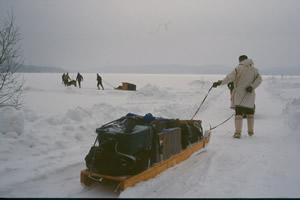
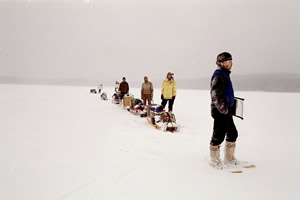
Although it’s a mild, gray and dull day, crossing Kawayaymog is easy. There is a beaten skidoo trail lined by spruce trees to start. After about 1 km, we keep going straight while the skidoo trails veers northwards. At the junction of the lake and Amable du Fond River, we stop, having traveled 3 km from the parking lot. However, days are short and it’s time to set up camp. It’s a pretty location, the dark open water running freely, about 15’ to 20’ wide and lined by low banks of contrasting white snow.
Setting up camp each night in a new location is a big production. With one big tent (13’ x 15’), seven tent poles at least 18’ to 22’ long need to be cut, depending on pole position and snow depth. Scissor poles needed to be the longest, sinking deep into the snow. My headlamp gets turned on about halfway through the production. Finally after about 3 hours, we are inside the tent, relaxing.
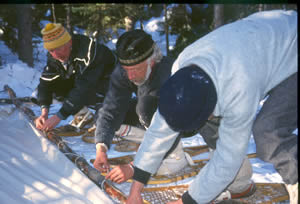
Although Karl couldn’t make the trip, his food certain did. Our first dinner is Karl’s chili – at this early stage in the trip, we are much too polite with each other to make jokes about the effects of beans. I hoover it down as well as some chocolate for desert. A slight oversight on my part: I didn’t realize I was to bring my own drinking cup (although we use common plates and cutlery). My nalgene bottle lid does double duty for the next 12 days. To sleep, we are neatly lined up with heads to the wall, feet to the middle. I scooped a corner at the back wall where it’s a bit cooler but perfect for me and my –40C bag. Everyone sacks out by 10pm, listening to the wind blow in tree tops.